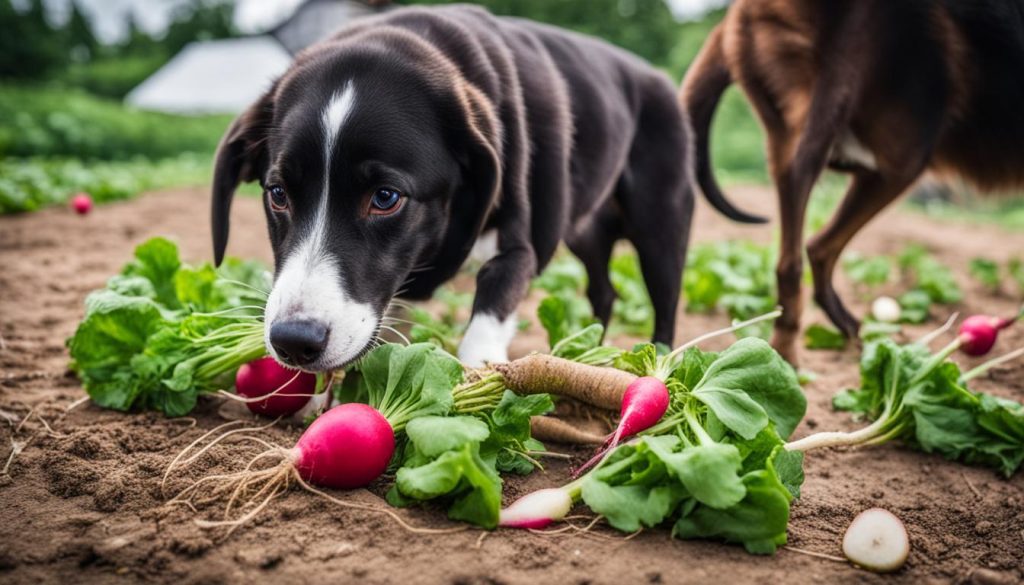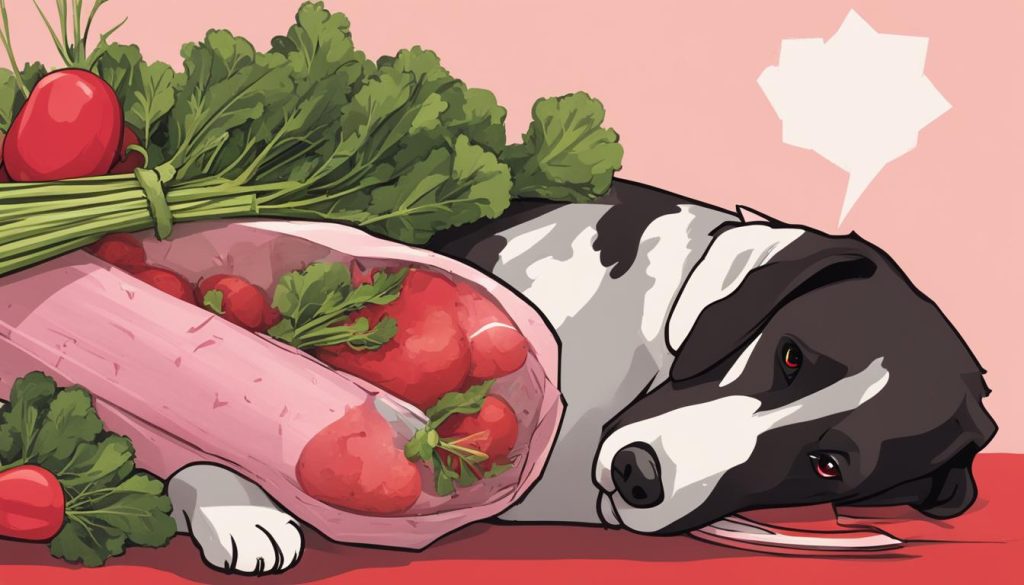As a pet parent, I’ve often found myself pondering over the safest snacks to share with my furry companion. With a plethora of human foods that are off-limits for our canine friends, it’s comforting to know that dogs can indeed enjoy the occasional radish. Understanding whether dogs can safely consume radishes is crucial, so we don’t unintentionally harm our beloved pets.
Rooted in nutrition, radishes offer a bevy of benefits for canines, aligning with a well-balanced dog diet. This crunchy vegetable is not only low in calories, but also boasts a high water content, making it an excellent hydrating snack. With the presence of important vitamins like vitamin C, radishes serve as an antioxidant powerhouse that works to neutralize harmful free radicals in our dogs’ bodies, and contribute to their overall health.
Most importantly, the calcium radishes contain goes a long way in supporting strong bones and healthy teeth. Equipped with high fiber content, radishes also promote solid digestive health and can keep our dogs feeling full without adding any unnecessary weight. When asking, “Can dogs eat radishes?” it’s imperative to recognize that when offered in moderation and prepared correctly, radishes can be a safe and nutritious addition to their diet.
Can Dogs Eat Radishes? Yes, in moderation, it is safe for them to eat.
- Radishes are a low-calorie, hydrating treat for dogs.
- They are rich in vitamin C and calcium for strong health.
- Radishes’ fiber aids in maintaining regular bowel movements in dogs.
- It’s important to serve radishes in moderation and without added seasonings.
- Preparation of radishes for dogs should involve washing, peeling, and chopping into small pieces.
- Always observe your dog for any adverse reactions when introducing new foods like radishes.
Exploring the Safety of Radishes for Dogs
As a conscientious dog owner, I’ve always been curious about are radishes safe for dogs. My research led me to Dr. Jerry Klein, the Chief Veterinary Officer for the AKC, who shed some light on the subject. He confirmed that radishes do indeed offer health benefits, such as being a natural source of fiber, calcium, and vitamins—all of which are advantageous for a dog’s muscle and heart health.

While researching, I learned about the different types of radishes and their potential effects on dogs. Dr. Klein pointed out that white radishes have a milder taste compared to their darker counterparts, which makes them more suitable as a treat for dogs. But, it’s not just the type of radish that matters; how they’re prepared is just as crucial.
There was an important cautionary note from Dr. Klein about radish greens. These leafy parts have been associated with causing gastrointestinal issues in dogs, leading to symptoms such as vomiting and diarrhea. Therefore, he strictly advises against including radish greens in our pet’s diet. Moreover, he warns against offering dogs any horseradish or wild radishes, as they can lead to gastrointestinal upset.
But don’t let these precautions deter you; it’s quite simple to safely incorporate plain radishes into your dog’s diet. All it takes is thoroughly washing, peeling, and chopping them into small, bite-size pieces to avoid any choking hazards. After all, ensuring our furry friends enjoy their snacks without any worries is what being a responsible pet owner is all about.
Can Dogs Eat Radishes: Understanding the Risks and Precautions
As a dog owner who’s always looking out for the health of my furry friend, it’s essential to understand the potential risks of feeding radishes to dogs. While these crunchy vegetables can be a healthy snack, certain precautions must be taken to ensure they’re safe for canine consumption.
Risks of Feeding Radishes to Dogs
The introduction of radishes in a dog’s diet may carry a risk of gastrointestinal upset in some dogs. I’m cautious about the radish greens, which can lead to gastroenteritis, whereas some radish variants like horseradish or wild radishes aren’t suitable for dogs at all. Ensuring radishes are properly prepared, by washing and cutting them into small pieces, helps mitigate these risks.

Appropriate Serving Sizes for Different Dog Breeds
I always consider my dog’s size when determining the correct serving size of radishes. A small piece, such as a 1/4-inch cube for a smaller dog, is a good starting point. Incrementally increasing the serving size to a maximum of three 1-inch cubes for a larger breed ensures that my dog can enjoy this tasty treat safely.
How to Identify and Address Potential Allergies
Although not common, it’s possible for dogs to have food allergies, so being vigilant when introducing radishes is key. I keep an eye out for any signs of an allergic reaction, such as itching or gastrointestinal upset. If I suspect my dog is allergic to radishes, I know to stop feeding them immediately and consult with a veterinarian to discuss what to do if your dog is allergic to radishes.
Nutritional Insights: Health Benefits of Radishes for Dogs
When I consider adding a new twist to my dog’s diet, the health benefits of radishes for dogs are remarkable and worthy of attention. I’ve discovered that these crisp, peppery vegetables are more than just a colorful addition to human salads—they’re a powerhouse of nutrition that can contribute positively to my dog’s health.
Radishes are a brilliant way for me to aid in my dog’s digestion, thanks to their high fiber content. But there’s more to these little red globes than meets the eye. They’re packed with vitamin C, which is known to bolster the immune system. Having a trustworthy immune system is crucial for my dog to live a healthy, vibrant life.
Another advantage I’ve noticed is how these crunchy roots promote proper muscle function and fluid balance due to their potassium richness. This is particularly beneficial after my pup’s long, energetic walks or during hot days when staying hydrated takes priority. Plus, I’m always conscious of calorie intake, and thanks to the low calorie content in radishes, they’re a guilt-free treat that doesn’t lead to unwanted weight gain—a win-win for maintaining my dog’s ideal weight.
Ultimately, considering radishes for my furry friend’s dietary plan has been a delightful discovery. It’s a joy to watch them crunch on this healthy veggie while reaping all its natural benefits.
Best Practices for Incorporating Radishes in a Dog’s Diet
When it comes to enriching my dog’s meals with a variety of nutrients, I carefully consider how to serve dogs radishes. Presenting these crunchy treats in a safe and appealing manner is just as important as choosing them for their health benefits. To start, I ensure that the radishes are thoroughly cleaned under running water. Preparing vegetables for dogs requires attention to detail; hence, I chop the radishes into small, bite-sized pieces ideal for my pup’s size to aid in easier digestion and prevent any choking hazards.
Proper Preparation and Serving Techniques
As I introduce new foods to my dog’s diet, such as radishes, I always keep close tabs on his reaction. Without any unnecessary seasonings, the natural flavor of radishes becomes a simple, pure treat. Even in their unadorned state, radishes offer a pop of flavor and texture that can be a delightful surprise for a canine’s palate. But, as with everything new, moderation is key—introducing radishes gradually ensures that these dog-safe vegetables are well-received.
Alternatives to Radishes for Dogs with Dietary Restrictions
If, for any reason, radishes don’t sit well with my dog, or he shows a distinct disinterest in them, I turn to other dog-friendly options. There’s a bounty of alternatives to radishes for dogs, such as carrots, which provide a great crunch, or green beans, known for their rich fiber content. These alternatives are more than just substitutes; they bring their unique set of nutrients that contribute to a varied and balanced diet for my furry friend.
Consulting with a Veterinarian Before Diet Changes
Before solidifying my decision to incorporate radishes or any fresh produce into my dog’s meals, consulting a vet about the dog diet adjustments is a step I never skip. This professional guidance is invaluable, particularly when considering a dog’s individual health concerns and nutritional needs. A veterinarian can also provide insights into whether a new addition like radishes will be beneficial or if my dog’s diet requires another strategy for optimal health.
Conclusion
Throughout our exploration into whether canines can safely have radishes as part of their diet, we’ve unearthed a positive verdict—they certainly can. This crunchy vegetable emerges as more than just a permissible snack; it stands out as a nutritious supplement offering hydration and a bevy of vitamins and minerals. The key is moderation and attentiveness to radishes and dog nutrition. As a pet owner, it’s imperative for me to monitor my dog’s individual response to these new additions, ensuring their experience remains positive.
It’s clear that radishes can play a beneficial role when responsibly introduced to your canine’s regimen. By adhering to the recommended serving sizes and preparation approaches, I can help maintain the safety and health of my furry friend. My priority is to keep any dietary transitions gradual, watching for any signs of gastrointestinal discomfort and always skipping the spicy variants that might lead to unwanted health issues. At the heart of it, radishes can be a pleasurable inclusion, forging a path to a more diverse and nutrient-rich diet.
Ultimately, in considering radishes for a dog’s diet, I’m reminded of the importance of professional guidance. Conversations with veterinarians remain indispensable, guiding me to make informed decisions tailored to my dog’s specific needs. So, as I ponder on ‘can dogs eat radishes?’ one last time, I conclude they can—with the proper oversight and the nod of approval from a trusted vet, ensuring every munch on this vegetable is just as rewarding for their health as it is for their taste buds.
FAQ
Can dogs eat radishes?
Yes, dogs can eat radishes in moderation. They’re low in calories and provide a good source of vitamins and minerals that can benefit a dog’s diet. However, it’s important to introduce this new food slowly and ensure it’s prepared appropriately for safe consumption.
Are radishes safe for dogs?
Radishes are generally safe for dogs if given as an occasional treat and in small quantities. They should be clean, peeled, and cut into small, bite-sized pieces to prevent choking hazards. Avoid giving dogs radish greens, as they can cause stomach upset.
What are the health benefits of radishes for dogs?
Radishes have several health benefits for dogs, such as being high in fiber, which aids in digestion, and containing antioxidants like vitamin C, which help bolster the immune system. They also provide hydration and contain calcium, which is essential for healthy bones and teeth.
What are the risks of feeding radishes to dogs?
While offering health benefits, radishes can also pose risks if not fed properly. The size and spice of certain radishes might not be well tolerated by all dogs, and radish greens can lead to gastroenteritis. Always observe your dog after introducing radishes to their diet to watch for any adverse reactions.
How much radish can I give to my dog?
The amount of radish a dog can have varies based on the dog’s size. As a general guide, an extra-small dog might start with a 1/4-inch cube, while an extra-large dog may have up to three 1-inch cubes. Introduce radishes slowly to see how your dog reacts to them before offering more.
What should I do if my dog is allergic to radishes?
If you suspect your dog is allergic to radishes, discontinue feeding them immediately and monitor for signs of allergic reactions, which may include itching, swelling, gastrointestinal upset, or difficulty breathing. Contact your veterinarian for an assessment and advice on managing the allergy.
How should radishes be prepared for dogs?
To prepare radishes for dogs, wash them thoroughly to remove any pesticides or dirt, peel to remove the tougher outer layer, and then chop them into small, manageable pieces that your dog can easily chew and digest. Avoid adding any seasonings or spices.
Are there alternatives to radishes for dogs with dietary restrictions?
Yes, if radishes aren’t suitable for your dog or they don’t like them, consider other dog-safe vegetables like carrots or green beans. These can also provide valuable nutrients and variety to your dog’s diet while adhering to their dietary restrictions.
Should I consult with a veterinarian before adding radishes to my dog’s diet?
Yes, it’s always wise to consult with a veterinarian before introducing new foods like radishes to your dog’s diet, especially if your dog has specific health conditions or dietary needs. Your vet can provide tailored advice to ensure safe and beneficial dietary changes for your dog.






